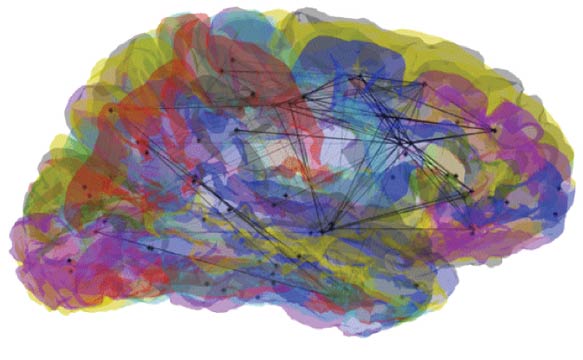
The human brain is a masterpiece of circuitry. In a squishy space about the size of an orange, the brain contains 100 billion neurons linked at trillions of critical spots known as synapses that conduct electrical signals to control our bodies, thoughts, and emotions, and make us who we are.
If scientists could diagram every connection, collectively known as the “connectome,” they’d have an anatomical map of brain function and, for the first time, a detailed way to understand what mistakes in this biological wiring cause neurological disease and psychiatric disorders. But given that there are more than 100 trillion synapses, well, that’s kind of a lot of work.
It’s also exactly what the Open Connectome Project is making possible. A Web platform that stores and manages 20 terabytes of brain image data, this Hopkins project puts the data online for scientists worldwide to tap and for users—including laypeople—to view and help analyze and annotate. (The project’s motto: “Collectively reverse-engineering the brain one synapse at a time.”)
“If you look at data online you can see neural structures, synapses, but it’s just image data,” says Randal Burns, associate professor in the Department of Computer Science and director of the Hopkins Storage Systems Labs. “Going from image data to information about connectivity—that’s the central challenge.”
An initiative of Hopkins’ Institute for Data Intensive Engineering and Science (IDIES) —a partnership of the Krieger School of Arts and Sciences, the Whiting School, and the Sheridan Libraries—the project is one of several Hopkins efforts aimed at designing computational tools to analyze the unprecedented flood of data collected via digital technologies. Like the Hopkins Sloan Digital Sky Survey, which seeks to map every object in the heavens, the Open Connectome Project leverages crowdsourcing and cloud computing to do large-scale science.
The project was born on a cocktail napkin when Burns met neuroscientist Josh Vogelstein, a postdoc in the Whiting School’s Department of Applied Mathematics and Statistics, at a dinner in March 2010. “Josh had this vision of an open connectome, and I had experience managing large datasets”—laying the groundwork for an ideal collaboration, says Burns.
The data already existed. Most data come from two Harvard laboratories that had collected a mountain of slices of mouse brain that they ran under an electron microscope; more data are expected from such institutions as the Max Planck Institute in Germany. The project also hosts brain data collected from magnetic resonance imaging. Over the past year, Burns and his students built a high-throughput storage system to house the data with Web Services to let users download it. The scientists now are working on making it possible for users to also upload any brain data they want to contribute—and annotate it.
And they’re developing a tutorial that will enable even laypeople to annotate data.
Participants will use a tool specifically designed to identify the neuron, bit of neuron, or synapse associated with each pixel in an image. “You need to know nothing about neuroscience or computers or annotating,” says Vogelstein. They expect to have hundreds of terabytes of data by next year, and petabytes in a few years. Given the scope of the project, the researchers hope many users will contribute the algorithms they write to identify cell boundaries or neurons. This “alg-sourcing” is crucial. Because the project is so vast and has so many parts, the researchers expect to use many algorithms together.
In addition to creating tools for image processing, Vogelstein’s brother, Jacob, a biomedical engineer at Hopkins’ Applied Physics Laboratory, is designing modular tools to combine these algorithms.
Since its launch in March 2011, the site has been getting more than 2,000 hits a month. “This is a big movement in open science. People anywhere in the world with Internet access can see and contribute to the most-cutting-edge science,” says Vogelstein. “It takes science out of the ivory tower and makes it available to everyone.”




